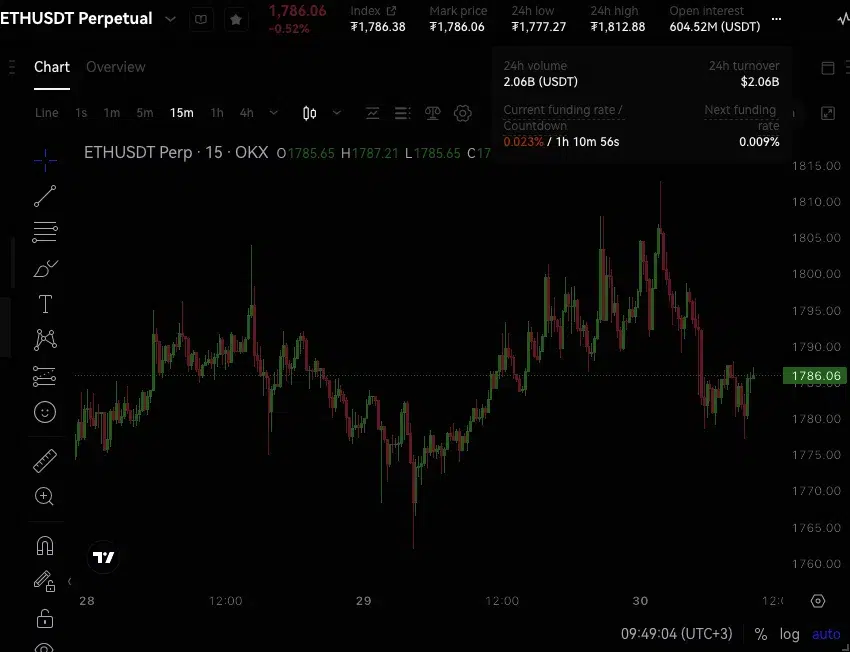Perpetual swap contracts come with the ability to leverage and settle a contract without having to own that underlying asset. This detailed guide walks you through becoming a successful perpetual swap contracts trader.
- What are Perpetual Swap Contracts?
- What are Crypto Derivatives?
- What is the Difference Between a Perpetual Swap and a Futures Contract?
- How to Trade Perpetual Swap Contracts
- Conclusion: Beginner’s Guide to Trading Perpetual Swap Contracts
Through the power of margin trading, perpetual swap contracts allow cryptocurrency traders to open large positions using less money. The advantage is that traders can take advantage of small price movements to make generate large profits.
This big reward is one of the enticing features of both perpetual swap contracts and futures contracts. However, with such enticing rewards comes enormous risk.
What are Perpetual Swap Contracts?
perpetual swap contracts are crypto derivatives that allow traders to open a long or short position without having to own the underlying asset. Unlike futures contracts which allow a long or short position for a specified period of time, perpetual swap contracts do not have a specified expiry date. For this reason, a perpetual swap contract can continue for an indefinite amount of time as long as it has sufficient margin to protect the position from liquidation or from loss. Hence, it’s upon a perpetual swap contracts trader to either cancel or close the contract.
Before delving into our step by step guide on trading perpetual contracts, it is worth introducing cryptocurrency derivatives. Just in case we have newbie traders in the house.
10/10 📝 Finally, weigh up the pros and cons of crypto perpetual swap contracts. High leverage, margin trading, hedging possibilities, and funding rate costs – just a few aspects we're unpacking in our in-depth analysis. #AQX
— Flipster (@FlipsterXYZ) May 11, 2023What are Crypto Derivatives?
A derivative is a price agreement between parties holding a different opinion on a cryptocurrency’s future price. On the agreed date or when the cryptocurrency hits that price, traders settle the differences between their price agreements.
In professional terms, a crypto derivative is a financial instrument that procures its value from the value of an underlying asset. Some people like to define it as a crypto copycat, mimicking the value of a cryptocurrency asset without actually owning it. If the price goes according to the trader’s price analysis, the trader wins. If it goes against their analysis, the trader loses. Options, Futures and Perpetual contracts are the three main types of derivatives.
Futures Contracts
A futures contract gives an investor the opportunity to speculate on the future price of a digital asset through an obligation to purchase or sell the asset on a particular date and at a predetermined price.
Options Contracts
Options on the hand provide the investor with the right and not the obligation to purchase or sell the underlying asset on a specified price and at a predetermined date.
Traders prefer derivatives because of their ability to generate profits without the risk exposure of hodling crypto assets. Peter started off speculating the price movements of cryptocurrency assets in early 2012 as a spot trader. In 2017, Peter discovered he could 100X his profit from small price movements by trading derivatives. Instead of the instant delivery of purchasing a crypto asset and selling it at a later date for a small profit in spot trading, Peter realized he could speed up the process a little bit using leverage and make bigger profits from short term price movements. The derivatives industry is awash with many success stories like Peter’s.
Data already suggests that perpetual swap contracts traders are accumulating as much as $180 billion in combined daily trading volumes. With only 7 years in existence, perpetual swap contracts seem to have enticed a large population of traders. It bears mentioning that the crypto exchange BitMEX was the first to introduce perpetual swap contracts in 2016.
What is the Difference Between a Perpetual Swap and a Futures Contract?
The key difference between a perpetual swap and a futures contract is that perpetual swap contracts lack an expiry date. Therefore, traders do not have to constantly re-establish their long or short positions. As a result, a perpetual contract’s value is tethered to the underlying asset’s spot prices. On the other hand, a futures contract has to be constantly re-established because the contract and the underlying asset’s value have to automatically converge towards the expiration date.
Since perpetual swap contracts do not have an expiration date, trading platforms implement a price anchor mechanism known as the funding rate mechanism.
What is the Funding Rate?
The funding rate mechanism enables an exchange to balance between long and short positions by incentivizing winning positions and dis-incentivizing losing positions. Think of it as a small fee that the traders pay or receive when trading perpetual swap contracts so as to ensure the price of the contract remains close to the underlying asset’s spot price.
How does the funding rate incentivize traders? For example, if a large number of traders believe the price will go up and they place long positions, short traders have to pay a fee to balance the mechanism. In case more traders have opened short positions, the long positions have to pay a small fee. This is vital to balance the price of the contract with that of the underlying asset’s actual price.
How Does an Exchange Calculate Funding Rates?
Suppose the price of Bitcoin is $30,000 on several exchanges, the funding rate ensures that the price of the perpetual contract is around that level. In general, the exchanges utilize an oscillating price marker when determining which side is winning between long and short positions. This price marker cartegorizes the funding rate into two, positive funding rate and negative funding rate.
- Positive funding rate: The funding rate is positive when the price of the perpetual contract is trading above the underlying asset’s real-time spot price. As a result, the long positions pay the short positions when the funding rate is positive.
- Negative funding rate: The funding rate is negative when the price of the perpetual swap is trading below the underlying asset’s real time price. Hence, the short positions have to pay the long positions.
The amount each trader receives when on the winning side is dependent on the size of their position. For example, if a ETH/USDT perpetual contract has a negative funding rate of +0.023% as shown on this OKX screenshot, a trader shorting $50,000 has to pay a fee of [0.023%* $50,000) to the long positions. I.e $11.5. Exchanges pay the funding fee at fixed intervals, for example OKX pays the funding rate at fixed intervals of 8-hours.

If perpetual swap contracts lacked a funding rate, traders would not have an incentive to counter price trends and open new positions. Besides, the perpetual swap cannot be anchored to the price of the underlying asset without the funding mechanism.
How to Trade Perpetual Swap Contracts
A trader with any amount of money can purchase a perpetual swap and sell it in future for additional profits without having to worry about an expiration date. However, the only limitation is that the trader requires to have enough margin to protect their perpetual swap position from liquidation. In the section below, we will discuss the ins and outs of successfully trading perpetual swap contracts. This is the most important section of this guide.
When a trader opens a perpetual swap position, the position will keep going unless it gets liquidated. To prevent liquidation, the trader needs to put into context an initial margin and a maintenance margin. Revisit our margin trading guide to understand initial and maintenance margin. Nonetheless, apart from the margin , the trader also needs to cover the small funding rate fees to keep the contracts price around the asset’s spot price.
Leverage, hedging and liquidity are three important features that entice most traders to perpetual swap contracts. Let’s take a look at each of these features more keenly:
Leverage
What is Leverage ?
Leverage is the most compelling aspect of trading cryptocurrency derivatives. When the Wallstreet Memes Coin launched a few weeks ago on OKX, traders could trade its perpetual swap with a leverage of upto 75X. Other perpetual swap contracts like BTC/USDT and ETH/USDT allows traders a leverage of upto 125X. What does this 75X or 125X mean? If a trader opened a WSM/USDT perpetual contract position with a 75X leverage using $1000. This means the trader has access to (75 X $1000 ) $75K.
In essence, this introduces the trader with the ability to magnify their profits , and their risks as well. For example, the price trading the opposite of the trader’s position can easily liquidate the $1000 if they lack a sound risk management strategy.
Hedging
‘All great innovations solve a problem’ said BitMEX on a blog post celebrating 5 years since creating the first perpetual swap contracts contract. According to the 2021 blog post, using traditional futures products in crypto was outdated due to the limitations of an expiry date. In essence, this limited the trader’s ability to place leveraged trades. For this reason, BitMEX pioneered the first perpetual swap contracts in crypto derivatives, enabling cryptocurrency traders to trade without stopping.
However, perpetual swap contracts did not just shine by the fact you could trade in a market that never stopped; what stood out for perpetual contracts was their hedging facility. This meant that traders could reduce their risk exposure against cryptocurrencies’ volatile nature. For example, supposing you own a few Bitcoins but you are scared the price could drop. Selling a perpetual swap contract can hedge your Bitcoins against the risk. Thereby, the contract serves as a safety net upon which your Bitcoin holdings are insured.
Liquidity
Despite the perpetual swap launching 7-years ago, the derivative was not an immediate success. However, volumes rose after 3-4 years of launching based perhaps on the rising interest in crypto during the 2019 Bitcoin bull run.
According to the aforementioned blog post, “the rising interest in crypto in those days surged, and with it rose the trading volumes for perpetual swap contracts’ which made them wonder what influenced the other. Nevertheless, BitMEX’s XBT/USD perpetual swap easily became the most traded digital assets derivatives product. In 2019, the derivative commanded over $3 trillion on the BitMEX exchange alone. Iterating the product across other exchanges resulted in an increasingly large number of traders using the perpetual swap feature. Experts developed more perpetual swap offerings including BTC , ETH among other altcoin perps.
On the foundations of this popularity, surging interest and increasing daily trading volumes, the perpetual swap contracts world is often characterized by extremely high liquidity. For this reason, exchanges can execute large perpetual swap contracts trades efficiently and quickly.
How Perpetual Swap Contracts Trading Works?
A Long Position (Illustratively)
Assuming Peter wants to open a position in the perpetual swap contracts market using $10,000 and a leverage of 5X. This means Peter can purchase a combined contract value of $50,000. Suppose Peter longs an ETH/USDT perpetual contract at $1800 each, he will calculate his profit as follows:
Number of Contracts he purchased at $1800 * Price Difference = profit
The price difference could be ETH/USDT perp contract rose from $1800 to $2000 = $200
- $50,000 / $1800 = 27.78 ETH/USDT contracts
- 27.78 ETH/USDT contracts * ($2000 – $1800) = $5556 in profit
Note: This calculation is a close estimate since it takes no account of the funding rates fees. The funding rate may affect the actual profit or loss but by a small margin. Additionally, Peter has taken account of the margin for funding the $50,000 debt. Essentially, he must take account of the margin to protect himself from potential liquidation risks. Remember that the trade going against Peter’s expectations would raze down his margin. Hence he must put inplace risk management controls such as margin calls and stop order limits.
What is Liquidation?
Liquidation happens when the unrealized loss on a trader’s account equals the amount that the trader deposited as margin for collateral. For example in Peter’s case, liquidation would happen if his unrealized loss hit $10,000. As such, Peter would lose his $10,000.
How Much Can You Lose When Trading Perpetual Swap Contracts?
Rather, how much can you lose incase of liquidation? Below is an example of a liquidated long position for the BIGTIME/USDT Perpetual contract:

On the above screenshot, Trader X lost $2254 after the price of BIGTIME/USDT perpetual contract dropped from the trader’s entry price of $0.2200 to $0.17514. Unlrealized loss hit 1537.27% of the trader’s account resulting in a catastrophic $2254 loss. One of the problems with margin trading without using sound risk controls like margin calls and stop losses is razing down a traders portfolio balance.
As shown on the screenshot, Trader X opened this particular position October 17th at a price of $0.2200, hoping that the price would rise probably to $0.25+ as it had happened the last 4 subsequent days. Another assumption this particular trader made could be that the price of BIGTIME/USDT was not going to drop below the $0.19 psychological support. Since the last time it had tested that level was 3 days ago. Even if it did break below the $0.19, chances of testing the trader’s liquidation mark were minimal. Or so he thought.
The price of the BIGTIME/USDT perpetual swap dropped catastrophically to $0.14 in 24 hours. Thereby liquidating massive long positions, including Trader X. This normally happens in crypto whenever there is a sudden market downturn or uptrend. For this reason, traders have to study the markets diligently, understand market fundamentals and draw sound technical analysis.
Conclusion: Beginner’s Guide to Trading Perpetual Swap Contracts
Conclusively, the process of trading perpetual swap contracts is risky but comes with the ability to speculate on large profits. Additionally, traders can benefit from a plunge in prices by shorting. Thereby making perpetual contracts one of the most enticing derivative products. Traders need to first study the art of trading with leverage, conduct due diligence, perform sound technical analysis and learn market fundamentals before engaging in perpetual swap contracts trading. However, we hope this guide explained it all.



















